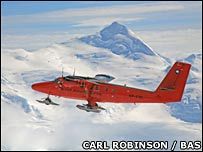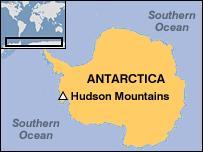They believe the volcano erupted about 2,000 years ago, and would have burst through its ice covering, producing a burst of steam and rocky debris.

|
| ©Carl Robinson/BAS |
| Data came from an airborne survey which made radar images |
The British Antarctic Survey (Bas) scientists report their finding in the journal Nature Geoscience.
They say it could aid understanding of an ice mass which is likely to play a key role in climate change.
The researchers discovered the eruption's traces by analysing radar data collected during an airborne survey of the area in 2004/5.
It showed a layer of volcanic ash - highly reflective to radar - that had been deposited on the ice surface and subsequently buried under successive years of snow in what are now the Hudson Mountains.

|
| ©Unknown |
In the middle of the area, the rock underneath the ice rises up in the shape of a mountain as much as 1km high.
The thickness of ice above suggests the eruption occurred just over 2,200 years ago.
"The discovery of a 'subglacial' volcanic eruption from beneath the Antarctic ice sheet is unique in itself," said Bas's Hugh Corr, lead author on the scientific paper.
"We believe this was the biggest eruption in Antarctica during the last 10,000 years. It blew a substantial hole in the ice sheet, and generated a plume of ash and gas that rose about 12km into the air."
Acid test
Additional evidence for the age of the eruption comes from ice cores that have been extracted from various parts of the white continent.
Many show, at about 2,200 years ago, a thin layer of ice which conducts electricity unusually well.
The Bas team suggests the volcano may well have been responsible, by blasting acids and other conductive chemicals into the air which subsequently fell to the ground and were incorporated into the ice.
"The ash and the sulphuric acid and so on would have been blasted out mixed up with steam from the melting ice," said David Vaughan of Bas, who also worked on the project.
"The ash came down in an elliptical pattern around the volcano, but the acid would have stayed up for much longer and drifted much further away before coming down," he told BBC News.
The Hudson Mountains lie close to Pine Island Glacier, one of the West Antarctic glaciers whose flow has accelerated in recent years.
Combined with satellite evidence showing that the West Antarctic sheet is losing mass, this had led some polar scientists to suggest that warmer ocean waters are accelerating the flow of ice into the sea. In the long run this could make a substantial contribution to rising sea levels.
But volcanoes which are not conspicuously active at present may also be generating heat under the ice.
"This one is probably producing heat and melt water," said Professor Vaughan. "That would end up under Pine Island Glacier and could be thinning it.
"This complicates things. However, it cannot explain the more widespread thinning of West Antarctic glaciers that together are contributing nearly 0.2mm per year to sea level rise."



Reader Comments
to our Newsletter